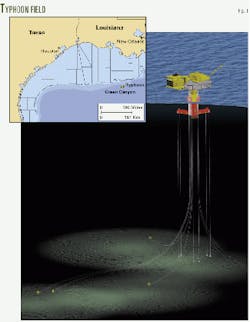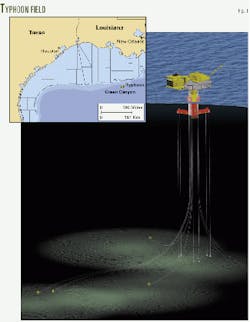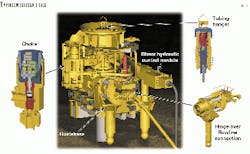A stab and hinge-over flowline connection system and direct-hydraulic control of subsea wells are two features that saved costs for the deepwater Typhoon development, 100 miles offshore Louisiana in Green Canyon Blocks 236 and 237.
Chevron USA Production Co. and BHP Petroleum Inc. are partners in the project that will have an Atlantia Offshore Ltd., Houston, mono-column, tension-leg platform, moored in 2,107 ft of water, and four Cameron subsea horizontal trees (Fig. 1).
Cameron is a division of Cooper Cameron Corp., Houston.
By going to a direct-hydraulic control of each well, instead of a subsea manifold system, the field operators estimate that development costs dropped by $9 million. They also estimate the project saved another $3.2 million primarily because the stab and hinge-over flowline connects will reduce lay vessel time that would have been required if inverted U jumpers were used.
Chevron and BHP plan to install the subsea trees this month, followed by the TLP installation in May 2001 and first production in August 2001.
Development plans call for the TLP to be moored with six tendons that connect to piles driven into the seabed. The topsides facilities are designed to handle 40,000 bo/d, 60 MMcfd gas, and 15,000 bw/d and are placed on two main decks and a cellar deck.
The topsides also houses a platform crane, vent boom, 22-man quarters building, and helideck.
Subsea trees
The subsea wells have Cameron modular subsea and integrated completions (MOSAIC) SpoolTrees (Fig. 2), which is Cameron's version of the horizontal tree.
Cameron says its MOSAIC systems are based on a combination of standard components that allow producers to specify pre-engineered components with application-specific features. The Typhoon trees do not have an integral body, although Cameron also manufactures the trees in that type of design.
In the Typhoon development, the guidelineless subsea trees will be installed on completion guidebases that land on the wells' 36-in. conductor housings. The guidebases incorporate two upward looking funnels. One funnel accommodates the innovative stab and hinge-over flowline connection system, while the second funnel is for the direct hydraulic control system.
Cameron says a drive-screw locking mechanism allows "infinite" adjustment of flowline-umbilical departure angles and locks the guidebase to the wellhead to transfer flowline-umbilical loads directly into the wellhead.
The subsea tree incorporates 4-in. and 2-in. gate valves and modular actuators on production and annulus master valves.
Hydraulically actuated gate valves control chemical injection. Two valves are for chemical injection at the tree and one valve controls downhole chemical injection.
Cameron has designed the trees to allow all valves to have remote-operated vehicle (ROV) override. Valve actuators are rated for 5,000-ft water. The subsea trees also have a retrievable 41/16-in., 10,000-psi working pressure (WP) subsea insert choke. The choke body remains downhole but the trim can be retrieved.
Cameron's tubing hanger lands in the subsea tree bore and is oriented via an orientation sleeve in the hanger. It has a 4-in. concentric bore with a 4-in. side production outlet, and can accommodate six downhole hydraulic lines, and one downhole electrical line.
The lines are for operating the 10,000 psi WP surfaced-controlled, subsurface safety valve (SCSSV) and providing for downhole chemical injection for controlling corrosion, paraffin, and asphaltenes.
In two Typhoon wells, which are completed in two zones, one line will handle hydraulic fluid for controlling a downhole "semi-smart" completion. The operators indicate that the main problem with smart completions has been with the electronics; therefore, they elected to install hydraulically operated downhole valves that have proven more reliable.
Cameron says the trees are also configured for pressure sensors both upstream and downstream of the choke, including a production temperature sensor and annulus pressure gauge.
The tree latches to the wellhead via a downhole mechanical dog and window connector. The tree includes a funnel up-funnel down design to align the tree isolation sleeve with the wellhead on the bottom and the tree running tool and blowout preventer (BOP) stack on the top.
Flowline connector
Cameron describes the flowline connection system as being a 41/16-in., 10,000 psi WP stab and hinge-over system that incorporates a minicollet connector to form a secure connection with the flexible flowline. This connector includes an integral hydraulic system to operate it, as well as the capability to externally test the connector gasket.
A nonintegral 41/16-in., 10,000 psi WP gate valve allows flowline isolation and testing. The design allows for 150,000 lb of flowline pull-in load.


